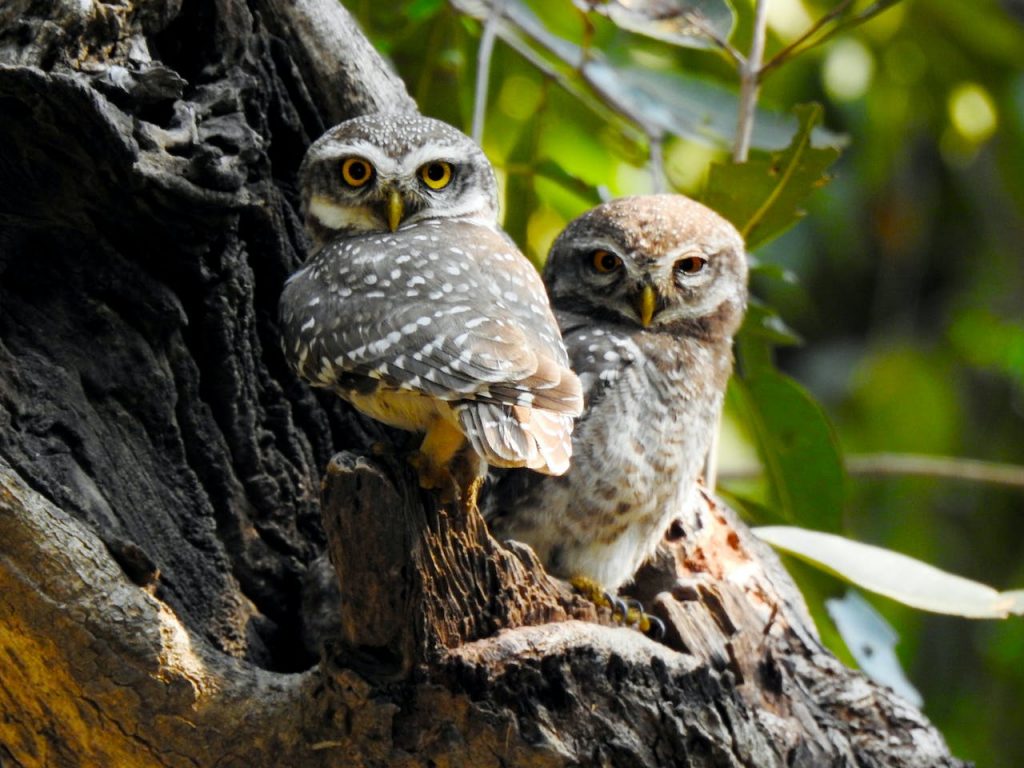Owls are a captivating group of birds characterized by their unmistakable round faces, intense gaze, and nocturnal habits. Classified under the order Strigiformes, these enigmatic creatures are renowned for their exceptional hunting prowess, facilitated by their sharp talons, keen hearing, and near-silent flight. They occupy diverse habitats across the globe, from dense forests and open prairies to urban environments.
In the United States, the diversity of owl species is particularly striking, with many unique types calling this region home. The United States is home to nineteen owl species, each with its unique characteristics. From the tiny Elf Owl to the majestic Great Gray Owl, these charismatic birds captivate people with their diverse shapes and sizes. This document aims to delve into the diversity and distribution of these owl species, offering a comprehensive exploration of their fascinating world.
Understanding Owl Diversity
Understanding the diversity of owl species in the United States is integral for owl enthusiasts and potential pet owners. Each species has unique needs and behaviors that must be respected and accommodated for proper care or observation. For instance, the diets of different owls vary greatly, ranging from small mammals to sizeable prey for larger species. Understanding these dietary needs is crucial for those considering an owl as a pet.
Similarly, knowing the habitats and behaviors of various owl species empowers enthusiasts to contribute meaningfully to their conservation and appreciate their crucial ecological roles. Deep knowledge of owl species fosters a richer, more respectful relationship with these magnificent creatures.
The Diverse World of Owl Species
Across the globe, there are approximately 250 species of owls, each exhibiting unique characteristics and adaptations to their specific habitats. Here are a few noteworthy examples:
- Great Horned Owl (Bubo virginianus) – Common across the Americas, this large owl species is recognizable by its tufted ears that resemble horns. They are adaptable and inhabit various ecosystems, including deserts, forests, and even suburban settings.
- Barn Owl (Tyto alba) – Known for its distinctive heart-shaped face, it has the widest distribution of any owl species, found on every continent except Antarctica.
- Snowy Owl (Bubo scandiacus) – Inhabiting the Arctic tundra, Snowy Owls are known for their stunning white plumage that serves as camouflage against the snow. They are one of the few owl species that are diurnal and active during the day.
- Elf Owl (Micrathene whitneyi) – As the smallest owl species, the Elf Owl stands only about 5 inches tall and is native to the southwestern United States and Mexico.
- Eurasian Eagle-Owl (Bubo bubo) – One of the largest and most powerful owl species, the Eurasian Eagle-Owl is found across Europe and Asia.
These are just a few examples of the astounding owl diversity worldwide. Each species plays a crucial role in their respective ecosystems, highlighting the importance of their conservation.
Owl Diversity and Distribution in the United States
The diversity and distribution of owls in the United States are remarkable. Of the approximately 250 species that exist worldwide, the United States hosts a significant 19 species, each varying in characteristics, size, and habitat preference.
Burrowing Owl (Athene cunicularia), as the name suggests, prefers open landscapes where it lives in burrows. Unlike most owl species, they are often seen during daylight hours. They are widely distributed throughout the western states and Florida.
The Northern Saw-whet Owl (Aegolius acadicus) is known for its cat-like eyes and oversized head. Primarily a bird of the dense northern forests, they are known to migrate south during the winter months.
The Eastern Screech Owl (Megascops asio) is prevalent in the eastern states, while its counterpart, the Western Screech Owl (Megascops kennicottii), inhabits the western regions. Both these species are well adapted to suburban and even urban environments.
The Great Gray Owl (Strix nebulosa), the world’s largest owl species by length, prefers the dense, coniferous forests of the northernmost and western states. Despite its size, it’s a rarely seen bird due to its preferred remote habitat and quiet demeanor.
Lastly, the Barred Owl (Strix varia) and the Spotted Owl (Strix occidentalis), often found in mature forests, have been subjects of intense study due to habitat conflicts with the logging industry.
This rich diversity of owl species in the United States showcases the breadth and depth of ecosystems available in the country. Moreover, it underscores the importance of preserving these habitats to ensure the survival and prosperity of these intriguing creatures.
Importance of Owl Classification
The classification of owl species holds critical importance from both ecological and conservation perspectives. Accurate categorization allows a more nuanced understanding of each species’ specific habitat requirements, dietary preferences, and behavior patterns. This information is vital to developing effective conservation strategies tailored to each species’ needs.
Furthermore, categorization aids in tracking species’ population trends, helping to detect any significant declines or changes in distribution that may signal environmental issues. From a research standpoint, classification facilitates comparative studies across species, leading to valuable insights into evolution, adaptation, and biodiversity. Understanding the diverse range of owl species contributes to a more holistic view of ecosystem health and inter-species dynamics.
Types of Owls Found in the United States
The owl species in the United States can be broadly classified into native and migratory. Native species reside in the country year-round, while migratory species spend part of their lives in other regions.
Common Owl Species in the U.S.
In the Northeast U.S., the Barred Owl (Strix varia) and the Eastern Screech Owl (Megascops asio) are commonly found. Both species thrive in forested areas, and the Eastern Screech Owl adapts well to suburban environments.
The Western Screech Owl (Megascops kennicottii) and the Great Horned Owl (Bubo virginianus) are frequently spotted in the Western U.S. The Western Screech Owl thrives in riparian woodlands, while the Great Horned Owl exhibits remarkable adaptability to various habitats.
In the Midwest, the Barn Owl (Tyto alba) is highly prevalent. These owls prefer open habitats like fields, farmlands, and meadows, often nesting in barns and other abandoned structures.
The Southwest is home to the smallest owl species, the Elf Owl (Micrathene whitneyi) and the Burrowing Owl (Athene cunicularia), known for its unique ground-dwelling habits.
In the Southeast, the Barred Owl and Eastern Screech Owl are common. At the same time, the Snowy Owl (Bubo scandiacus) is a notable winter visitor in the Northern U.S., venturing south from its Arctic tundra habitats during the colder months.
Lesser-Known Owl Species
While the aforementioned owl species are relatively common, the United States hosts several lesser-known and rarer ones. Some of these elusive species include:
Flammulated Owl (Psiloscops flammeolus) – These small owls, characterized by their flame-colored feathers, are primarily found in the mountainous regions of the Western U.S. They inhabit old-growth forests and are known for their elusive nature, making them challenging to spot.
Northern Pygmy Owl (Glaucidium gnoma) – Despite their small size, these owls are fierce predators. They inhabit the mountainous, coniferous forests of the West and Northwest U.S.
Boreal Owl (Aegolius funereus) – Named after the boreal or northern forests they inhabit, these owls are found in the northernmost regions of the U.S., especially Alaska and the Rocky Mountains region. They are nocturnal and favor dense, old-growth forests.
Long-Eared Owl (Asio otus) – With tufts that resemble ears, these owls are primarily found in the dense forests of the Northern U.S. However, they have a wide range that extends to some parts of the West and Midwest.
Short-Eared Owl (Asio flammeus) – Unlike its long-eared counterpart, it is primarily found in open habitats like grasslands and marshes. Its extensive range covers parts of the West, Midwest, and Northeast U.S.
These species, although not as commonly encountered as their more prevalent counterparts, contribute significantly to the ecological diversity and richness of the United States. Their presence underlines the importance of preserving various habitats across the nation to support the survival of all owl species.
Factors Affecting Owl Populations
Various factors, including habitat loss, climate change, and human interference, continually impact the diversity and distribution of owl species. Urbanization, logging, and other land-use changes often affect owls’ habitats, leading to fragmentation and degradation of their natural environments. This pressure can lead to declines in population numbers or even local extinctions.
Habitat Loss and Human Impact
Human activities significantly, often detrimental, affect owl populations and their habitats. The expansion of urban areas, intensive farming, and deforestation result in habitat loss and fragmentation, a primary threat to many owl species. For instance, the Spotted Owl, native to the old-growth forests of the Pacific Northwest, has declined due to extensive logging in its habitat.
Furthermore, pesticides and other chemicals in agriculture can have a ripple effect on the food chain, impacting owls’ dietary sources. These chemicals can accumulate in the bodies of small mammals and insects that owls ingest, leading to potential poisoning or disruption in their reproductive abilities.
Light pollution is another human-induced factor that disturbs the nocturnal lifestyle of many owl species. Increased ambient light can disrupt their hunting patterns and interfere with their natural rhythms.
Lastly, climate change, driven by human activities such as burning fossil fuels, alters the distribution of species and the availability of resources, possibly pushing owls out of their natural habitats. As temperatures rise, the habitats of some owl species may shift northwards, altering the geographical range of owl distributions in the United States.
In sum, human activities create a variety of environmental pressures that can significantly impact owl populations, prompting the need for protective measures and conservation efforts to ensure their survival.
Climate Change and Owl Habitats
Climate change profoundly impacts the habitats and survival of owl species. As global temperatures rise, ecosystems undergo significant shifts, leading to alterations in the distribution of prey, habitat suitability, and the timing of critical life-cycle events, such as reproduction and migration.
Rising temperatures can lead to changes in the vegetation and prey availability in various habitats, directly affecting owls’ food supply. For instance, changing climate conditions can affect the population of rodents, a primary food source for many owl species. Reduced prey availability can force owls to expand their hunting territories, increasing competition and potentially leading to conflict or displacement of some species.
Moreover, some owl species, like the Boreal Owl and the Snowy Owl, are susceptible to climatic changes due to their specialized habitats. Warming temperatures could result in the loss of the cold, northern habitats that these species depend on, pushing them further north and reducing their geographic range.
Furthermore, climate changes can disrupt the timing of breeding seasons. Owls typically time their breeding to coincide with peak prey availability to ensure the successful rearing of their chicks. Changes in temperature patterns can shift the peak abundance of prey, creating a mismatch between breeding and prey availability.
Lastly, extreme weather events, such as storms and wildfires, becoming more frequent due to climate change, can directly threaten owl populations. Such events can destroy nests, cause food shortages, and lead to the death of young or weak individuals.
Adapting to these rapidly changing conditions poses a significant challenge for owls. While some species may be able to adjust to a certain extent, others with specialized habitat requirements or slower reproductive rates may struggle. This underscores the significance of climate change considerations in conservation efforts for these incredible creatures.
Owl Conservation and Wellness
Efforts to conserve owl species in the United States are ongoing and multifaceted. Conservation efforts include habitat protection, research, education, and even rehabilitation of injured or orphaned owls.
Conservation Initiatives in the U.S.
Several conservation initiatives are active in the United States, dedicated to preserving and protecting owl species. The American Bird Conservancy conducts projects throughout the U.S. that benefit owls, including habitat protection and restoration efforts to maintain the diverse ecosystems that owls call home. In the Pacific Northwest, the Spotted Owl Recovery Project focuses specifically on preserving the old-growth forest habitats this species depends on.
Another key organization is the Raptor Resource Project, which undertakes initiatives to safeguard falcon, eagle, and owl populations. Their work includes monitoring and tracking owl populations and undertaking measures to enhance their habitats, notably by installing nest boxes aiding in breeding species such as the Barn Owl.
The International Owl Center in Minnesota champions owl preservation on multiple fronts. They conduct scientific research, provide rescue and rehabilitation services for injured or orphaned owls, and operate an education program to raise public awareness about owl conservation.
In Arizona, the Wild at Heart organization specializes in the rescue, rehabilitation, and relocation of Burrowing Owls, working on projects to create artificial burrows for these unique ground-dwelling birds.
Additionally, nationwide initiatives like the Christmas Bird Count and the Great Backyard Bird Count engage citizen scientists in monitoring owl populations, providing valuable data for conservation efforts.
These initiatives, among others, underscore a collective commitment to protecting these remarkable creatures and their diverse habitats. Their work is crucial in mitigating the impacts of habitat loss, climate change, and other threats facing owl species today.
Owls in Captivity: Wellness and Care Tips
While caring for owls in a captive setting or as pets can be a rewarding experience, it entails a significant level of commitment and specialized knowledge to ensure their well-being. Here are some crucial considerations when caring for owls:
Legal Requirements: First and foremost, it’s important to note that keeping owls as pets is often regulated by strict legal requirements. Maintaining owls without a special permit is illegal in many areas, usually granted for educational, rehabilitation, or research purposes. Always verify your local laws before acquiring an owl.
Specialized Diet: Owls are carnivorous and require a diet mainly comprising whole prey items, such as mice, rats, and chicks. Their food must be fresh and ideally mimic their natural diet in the wild. Feeding owls appropriately is vital for their health and psychological well-being, as hunting and tearing apart prey are instinctive behaviors.
Adequate Space: Owls need ample space to move and exercise. The size of the aviary should be proportionate to the size of the owl, allowing it to fly and perch comfortably. The enclosure should also be secure, well-ventilated, and equipped with sheltered areas for the owl to retreat.
Environmental Enrichment: Owls in captivity benefit from ecological enrichment – objects or features that encourage natural behaviors and provide mental stimulation. This can include various perch types, hiding spots, and items to manipulate or “hunt.”
Medical Care: Regular veterinary care is crucial for maintaining an owl’s health. A veterinarian specializing in avian or exotic animals can provide appropriate vaccinations, parasite management, and regular health check-ups.
Special Considerations: Owls are naturally nocturnal, so their activities typically occur at night. They also do not show affection in the same way as domesticated pets such as dogs and cats; they are wild animals with specific behaviors and needs.
While caring for an owl may seem appealing, it’s crucial to remember that these wild animals have complex needs. They typically fare best in their natural habitats, free to exhibit their natural behavior. If you wish to contribute to the welfare of owls, consider supporting conservation efforts or rehabilitation centers dedicated to these magnificent birds.
Conclusion
The United States boasts diverse owl species with distinctive characteristics, habitats, and behaviors. From the compact yet fierce Northern Saw-whet Owl to the imposing Great Horned Owl, the owl species in the U.S. inhabit various environments, including coniferous forests, grasslands, marshes, and northern forests. The Boreal Owl, Long-Eared Owl, and Short-Eared Owl are prime species that highlight the country’s ecological diversity.
However, these species and others face numerous challenges due to habitat loss, climate change, and human interference, factors that continually impact their numbers and distribution. Though multifaceted and ongoing, conservation efforts are critical to preserve the owl species and their habitats, signifying the need for continued vigilance and action in the face of environmental threats.





